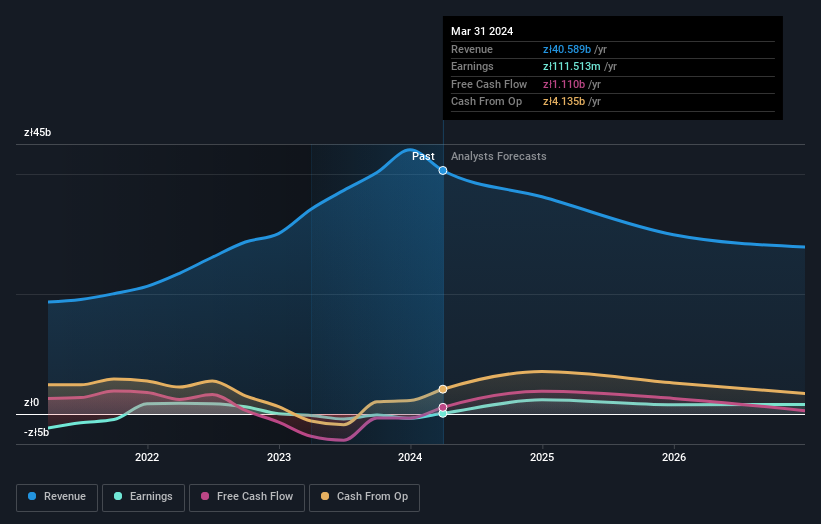- Poland
- /
- Electric Utilities
- /
- WSE:ENA
State or government in ENEA S.A. (WSE:ENA) are its biggest bettors, and their bets paid off as stock gained 9.4% last week

Key Insights
- The considerable ownership by state or government in ENEA indicates that they collectively have a greater say in management and business strategy
- The largest shareholder of the company is Ministry of State Treasury with a 52% stake
- Institutional ownership in ENEA is 14%
To get a sense of who is truly in control of ENEA S.A. (WSE:ENA), it is important to understand the ownership structure of the business. We can see that state or government own the lion's share in the company with 52% ownership. Put another way, the group faces the maximum upside potential (or downside risk).
As a result, state or government were the biggest beneficiaries of last week’s 9.4% gain.
Let's take a closer look to see what the different types of shareholders can tell us about ENEA.
View our latest analysis for ENEA

What Does The Institutional Ownership Tell Us About ENEA?
Many institutions measure their performance against an index that approximates the local market. So they usually pay more attention to companies that are included in major indices.
As you can see, institutional investors have a fair amount of stake in ENEA. This suggests some credibility amongst professional investors. But we can't rely on that fact alone since institutions make bad investments sometimes, just like everyone does. It is not uncommon to see a big share price drop if two large institutional investors try to sell out of a stock at the same time. So it is worth checking the past earnings trajectory of ENEA, (below). Of course, keep in mind that there are other factors to consider, too.

Hedge funds don't have many shares in ENEA. The company's largest shareholder is Ministry of State Treasury, with ownership of 52%. This implies that they have majority interest control of the future of the company. In comparison, the second and third largest shareholders hold about 2.6% and 2.1% of the stock.
While studying institutional ownership for a company can add value to your research, it is also a good practice to research analyst recommendations to get a deeper understand of a stock's expected performance. There are plenty of analysts covering the stock, so it might be worth seeing what they are forecasting, too.
Insider Ownership Of ENEA
The definition of company insiders can be subjective and does vary between jurisdictions. Our data reflects individual insiders, capturing board members at the very least. Management ultimately answers to the board. However, it is not uncommon for managers to be executive board members, especially if they are a founder or the CEO.
Insider ownership is positive when it signals leadership are thinking like the true owners of the company. However, high insider ownership can also give immense power to a small group within the company. This can be negative in some circumstances.
Our information suggests that ENEA S.A. insiders own under 1% of the company. It is a pretty big company, so it would be possible for board members to own a meaningful interest in the company, without owning much of a proportional interest. In this case, they own around zł44k worth of shares (at current prices). It is always good to see at least some insider ownership, but it might be worth checking if those insiders have been selling.
General Public Ownership
With a 33% ownership, the general public, mostly comprising of individual investors, have some degree of sway over ENEA. This size of ownership, while considerable, may not be enough to change company policy if the decision is not in sync with other large shareholders.
Next Steps:
While it is well worth considering the different groups that own a company, there are other factors that are even more important. For example, we've discovered 1 warning sign for ENEA that you should be aware of before investing here.
If you would prefer discover what analysts are predicting in terms of future growth, do not miss this free report on analyst forecasts.
NB: Figures in this article are calculated using data from the last twelve months, which refer to the 12-month period ending on the last date of the month the financial statement is dated. This may not be consistent with full year annual report figures.
Valuation is complex, but we're here to simplify it.
Discover if ENEA might be undervalued or overvalued with our detailed analysis, featuring fair value estimates, potential risks, dividends, insider trades, and its financial condition.
Access Free AnalysisHave feedback on this article? Concerned about the content? Get in touch with us directly. Alternatively, email editorial-team (at) simplywallst.com.
This article by Simply Wall St is general in nature. We provide commentary based on historical data and analyst forecasts only using an unbiased methodology and our articles are not intended to be financial advice. It does not constitute a recommendation to buy or sell any stock, and does not take account of your objectives, or your financial situation. We aim to bring you long-term focused analysis driven by fundamental data. Note that our analysis may not factor in the latest price-sensitive company announcements or qualitative material. Simply Wall St has no position in any stocks mentioned.
Have feedback on this article? Concerned about the content? Get in touch with us directly. Alternatively, email editorial-team@simplywallst.com
About WSE:ENA
ENEA
Generates, transmits, distributes, and trades in electricity in Poland.
Flawless balance sheet and fair value.


